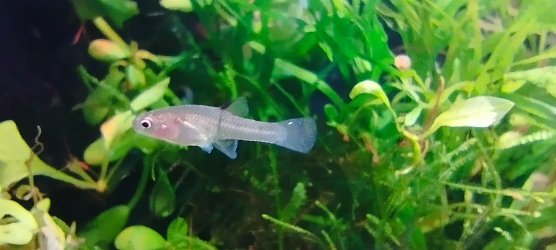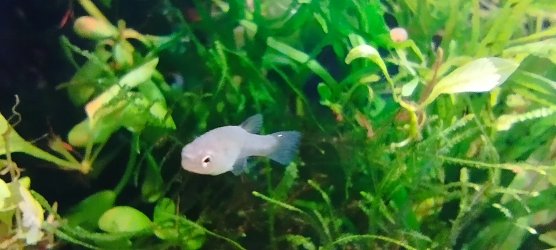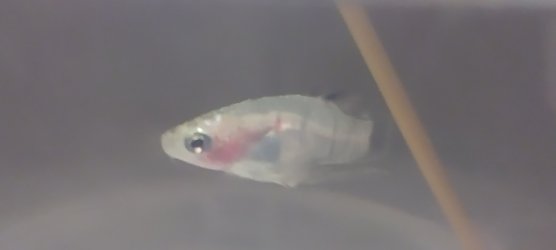Abaddon
Fish Fanatic
Hi again 
I wish I could come on here just to make happy/show-off posts, but the aquarium gods have not been kind to me recently & I have to ask for some help/advice AGAIN I recently (~2 weeks ago) got some new livebearers (poecilids), which I unfortunately wasn't able to fully quarantine (my 1 and only QT had a sick fish in it at the time). They went into empty tanks & are going to be the only fish species in there as they are very shy and don't do well in community setups at all, even with similar species. Most of them were very young upon arrival (maybe a few weeks old) and they are SUPER tiny (most of them are under half an inch long). Everything was fine in the beginning, but recently I noticed some microscopic whitish & opaque patches (mostly on their tails). I took out one of the males which was a bit more severely affected - he had tiny dots on his body as well, and was rubbing against surfaces more than the others. The first weird thing I noticed about him upon arrival was that he had a weird white thing that kept going in and out of his mouth (I thought it was a piece of food at first), which disappeared after a few days, but then he started to develop those tiny whitish bumps/spots. The dots protrude slightly from the body, but they are quite difficult to see (maybe because the fish are so small). I've since noticed more fish with these weird spots on their tails, so whatever it is seems to be spreading. One of the younger females has developed a very visible white spot (pictured), but Idk if this is the same thing or something different. The other fish are difficult to photograph since they're so small and the discolouration is not very obvious even to the naked eye, unless you look very closely. The only thing that happened recently was a brief heatwave, but the temperature only increased by about 2-3 degrees Celsius and never went beyond what this species normally experiences in the wild - and it only lasted a couple of days. But that's when I started noticing more of the symptoms, so Idk
I recently (~2 weeks ago) got some new livebearers (poecilids), which I unfortunately wasn't able to fully quarantine (my 1 and only QT had a sick fish in it at the time). They went into empty tanks & are going to be the only fish species in there as they are very shy and don't do well in community setups at all, even with similar species. Most of them were very young upon arrival (maybe a few weeks old) and they are SUPER tiny (most of them are under half an inch long). Everything was fine in the beginning, but recently I noticed some microscopic whitish & opaque patches (mostly on their tails). I took out one of the males which was a bit more severely affected - he had tiny dots on his body as well, and was rubbing against surfaces more than the others. The first weird thing I noticed about him upon arrival was that he had a weird white thing that kept going in and out of his mouth (I thought it was a piece of food at first), which disappeared after a few days, but then he started to develop those tiny whitish bumps/spots. The dots protrude slightly from the body, but they are quite difficult to see (maybe because the fish are so small). I've since noticed more fish with these weird spots on their tails, so whatever it is seems to be spreading. One of the younger females has developed a very visible white spot (pictured), but Idk if this is the same thing or something different. The other fish are difficult to photograph since they're so small and the discolouration is not very obvious even to the naked eye, unless you look very closely. The only thing that happened recently was a brief heatwave, but the temperature only increased by about 2-3 degrees Celsius and never went beyond what this species normally experiences in the wild - and it only lasted a couple of days. But that's when I started noticing more of the symptoms, so Idk  The fish show no other symptoms other than very occasional flashing (and shimmying, but that's only happened during acclimation and treatment in a separate container, never in the main tanks, so it could just be stress-induced). They're active, eating & swimming well, interested in breeding and their poop is healthy. No laboured breathing or hanging out at the surface either. I haven't lost a single fish & I hope I don't, but it doesn't look like something that I can ignore either. So far I've "narrowed"
The fish show no other symptoms other than very occasional flashing (and shimmying, but that's only happened during acclimation and treatment in a separate container, never in the main tanks, so it could just be stress-induced). They're active, eating & swimming well, interested in breeding and their poop is healthy. No laboured breathing or hanging out at the surface either. I haven't lost a single fish & I hope I don't, but it doesn't look like something that I can ignore either. So far I've "narrowed" it down to a few options:
it down to a few options:
1. Ich
2. Another ectoparasite / fluke
3. Velvet
4. Early stages of columnaris (but I feel like they would probably be in much worse condition by now...?)
5. Tetrahymena
6. Fungus...? (one of the other males has a diffuse opaque patch on his tail, but there's no fraying & it's not fuzzy)
I've isolated the sickest male and started treating him with eSHa 2000 (ethacridine lactate, copper, methyl orange & proflavine) but it hasn't had any noticeable effect. Thing is, the tank is heavily planted and has inverts in it, so I'm a bit limited in my treatment options (like salt). I've ordered eSHa Exit, which supposedly targets a variety of parasites including ich, velvet and tetrahymena (and is safe for plants & other critters). It's copper-free, but contains methylene blue and malachite green in addition to the e. lactate. Am I on the right track with this?
Any insights would be welcome, including from people who have used eSHa products before. The Exit thing claims to get rid of ich in as little as 3-5 days without the need to raise temperature, which I find a bit odd tbh, but it has very god reviews online so Idk.
Tank parameters:
Ammonia: precise value unknown, Seachem badge shows NH3 within the "safe" range (i.e. under or around 0.02ppm)
Nitrites: 0
Nitrates: 0
GH: 13-15dh
KH: 8
pH: unknown, according to the city website the tapwater is usually around 7.7
[If I can get clearer pictures I will, but it's not easy lol]
I wish I could come on here just to make happy/show-off posts, but the aquarium gods have not been kind to me recently & I have to ask for some help/advice AGAIN
 The fish show no other symptoms other than very occasional flashing (and shimmying, but that's only happened during acclimation and treatment in a separate container, never in the main tanks, so it could just be stress-induced). They're active, eating & swimming well, interested in breeding and their poop is healthy. No laboured breathing or hanging out at the surface either. I haven't lost a single fish & I hope I don't, but it doesn't look like something that I can ignore either. So far I've "narrowed"
The fish show no other symptoms other than very occasional flashing (and shimmying, but that's only happened during acclimation and treatment in a separate container, never in the main tanks, so it could just be stress-induced). They're active, eating & swimming well, interested in breeding and their poop is healthy. No laboured breathing or hanging out at the surface either. I haven't lost a single fish & I hope I don't, but it doesn't look like something that I can ignore either. So far I've "narrowed"1. Ich
2. Another ectoparasite / fluke
3. Velvet
4. Early stages of columnaris (but I feel like they would probably be in much worse condition by now...?)
5. Tetrahymena
6. Fungus...? (one of the other males has a diffuse opaque patch on his tail, but there's no fraying & it's not fuzzy)
I've isolated the sickest male and started treating him with eSHa 2000 (ethacridine lactate, copper, methyl orange & proflavine) but it hasn't had any noticeable effect. Thing is, the tank is heavily planted and has inverts in it, so I'm a bit limited in my treatment options (like salt). I've ordered eSHa Exit, which supposedly targets a variety of parasites including ich, velvet and tetrahymena (and is safe for plants & other critters). It's copper-free, but contains methylene blue and malachite green in addition to the e. lactate. Am I on the right track with this?
Any insights would be welcome, including from people who have used eSHa products before. The Exit thing claims to get rid of ich in as little as 3-5 days without the need to raise temperature, which I find a bit odd tbh, but it has very god reviews online so Idk.
Tank parameters:
Ammonia: precise value unknown, Seachem badge shows NH3 within the "safe" range (i.e. under or around 0.02ppm)
Nitrites: 0
Nitrates: 0
GH: 13-15dh
KH: 8
pH: unknown, according to the city website the tapwater is usually around 7.7
[If I can get clearer pictures I will, but it's not easy lol]





